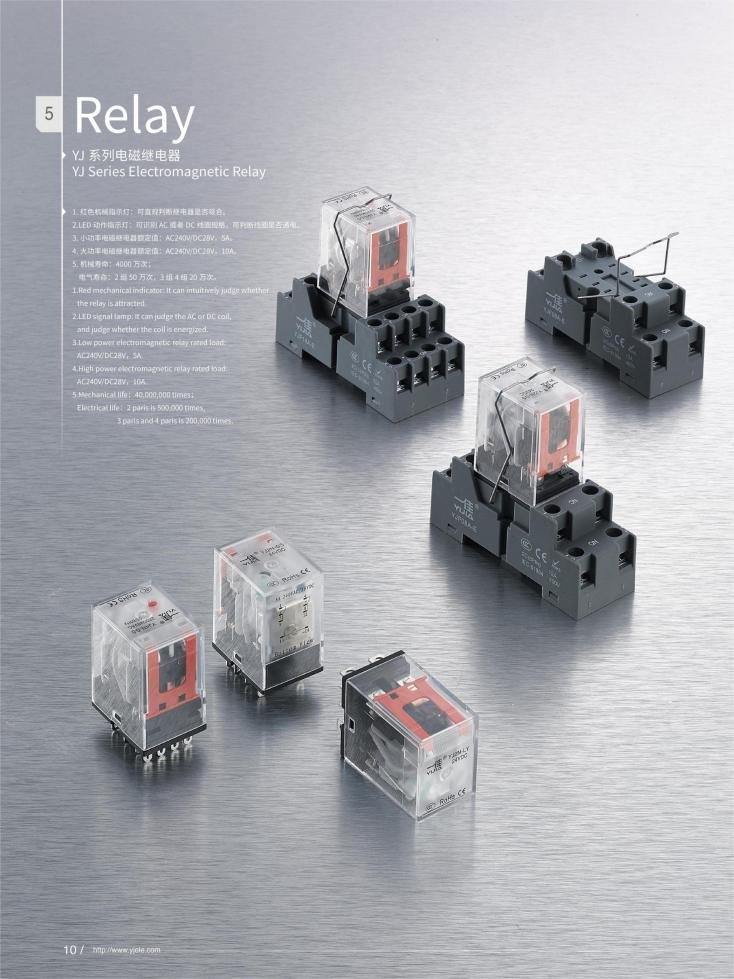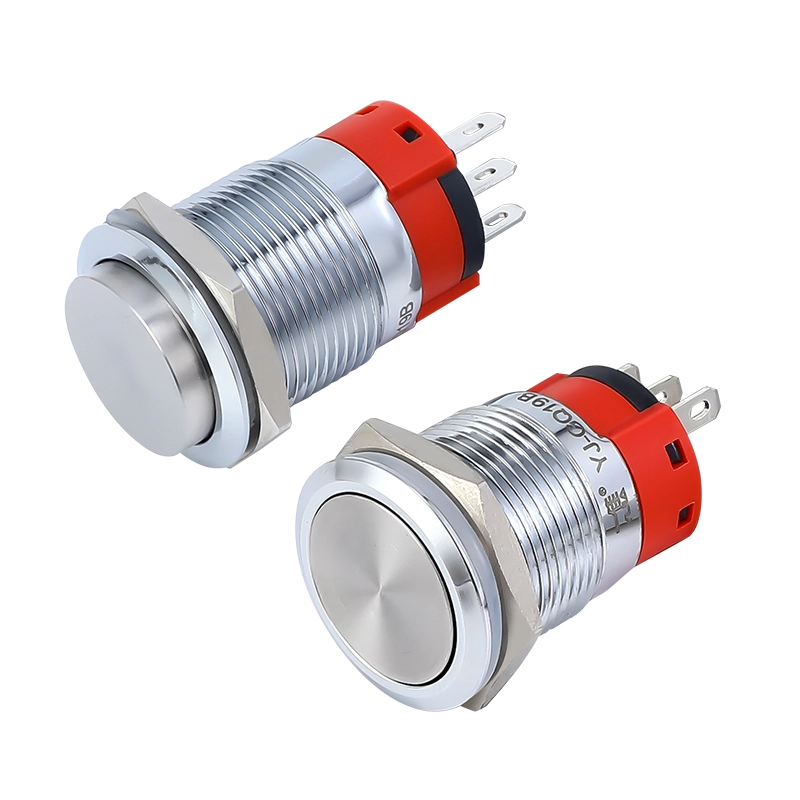A Practical Guide to Relay Switching Circuits
What is a relay switch circuit?
Relay switching circuit is an electrical control system mainly composed of relays. A relay is an electromagnetic switch capable of controlling one or more high-current or high-voltage circuits in an electrical circuit, operating with a lower voltage or current control signal. This kind of circuit is widely used in automation control and power systems, and can realize remote control and load switching, increasing the safety and flexibility of the circuit.
The core component of a relay switching circuit is the relay itself, which consists of basic components such as coils, contacts, and springs. When the coil is driven by current, a magnetic force is generated, which attracts the contacts to close or release, thereby opening or closing the circuit. In this way, relays are able to electrically isolate between different circuits while controlling larger currents.
Features and working principles
The main features of relay switching circuits include:
- Electrical isolation: Relays provide electrical isolation between inputs and outputs, protecting circuits from the direct effects of high voltages or high currents.
- Strong controllability: Only a small current or voltage is needed to control the relay, allowing it to control larger currents and achieve efficient energy conversion and control.
- Flexibility and adaptability: Relay switching circuits can be designed to meet specific functions and needs, and are suitable for a variety of different application scenarios.
- Fast response speed: The response time of the relay is usually in the millisecond level, which is suitable for applications that require fast switching.
Here’s how it works:
- When a control circuit (such as a button, sensor, or logic circuit) applies current to a relay’s coil, the coil creates a magnetic field.
- This magnetic field attracts an iron core and drives the contacts connected to the iron core to move, usually closing (making) or opening (cutting off) the contacts in the circuit.
- Movement of the contacts directly changes the state of the load circuit, such as turning a light or motor on or off.
- When the control signal disappears, the magnetic force of the coil disappears, the contacts return to their original positions under the action of the spring, and the circuit returns to its original state.
Types of relay switching circuits
Classification according to relay working mode
Relay switching circuits can be classified into the following two main types based on how they work:
1. Electromagnetic relay:
- Principle: The electromagnetic relay uses an electromagnet to attract a movable iron core to drive the opening and closing of the contacts.
- Features: It has the advantages of high reliability, low cost and easy maintenance. But because it contains mechanical moving parts, it has slow response times and suffers from wear and noise issues.
- Application: Widely used in household appliances, industrial control systems and other occasions.
2. Solid state relay (SSR):
- Principle: It does not contain mechanical moving parts and uses semiconductor switching elements (such as transistors) to realize the switching of the circuit.
- Features: fast response, good anti-vibration performance, long life, but the cost is relatively high, and additional cooling facilities may be required under high loads.
- Application: Suitable for high-speed automation equipment that requires frequent switching and environments with high requirements on noise and mechanical wear.
Classification by contact form
The forms of relay contacts are classified according to their behavioral characteristics in the circuit:
1. Normally open contact (Normally Open, NO):
- Features: When the relay is not activated, the contacts are open. Only closes when the relay is activated.
- Application: Commonly used in control circuits that need to start equipment under specific conditions.
2. Normally Closed (NC):
- Features: When the relay is not activated, the contacts are closed. The contacts open when the relay is activated.
- Application: Often used in safety or emergency stop systems to ensure automatic circuit disconnection in the event of control failure.
3. Transfer contact (Double Throw, DT):
- Features: Both normally open and normally closed contacts can be switched between the two states, providing greater flexibility.
- Application: Suitable for circuits that need to control two operating modes at the same time.
Classification by coil voltage
According to the operating voltage of the relay coil, relays can be divided into the following two categories:
1. Low voltage relay:
- Voltage range: usually 5V, 12V or 24V, etc.
- Features: Suitable for low voltage applications, such as small equipment or low voltage control systems.
- Application: Widely used in consumer electronics, automotive electronics and some automation equipment.
2. High voltage relay:
- Voltage range: 120V, 240V or higher.
- Features: Able to handle high voltage and current, suitable for heavy-duty applications.
- Application: Mainly used in industrial environments, such as power systems and large machinery control systems.
Advantages and Disadvantages of Relay Switching Circuits
Relay switching circuits have several advantages and some potential disadvantages that determine their suitability and performance in different applications:
Advantage
- Good isolation performance: The relay provides good electrical isolation, which can effectively separate the control signal and high-voltage load, and protect the low-voltage control system from being affected by high-voltage circuits.
- Flexible control: Relays can control larger currents with very small currents or voltages, making them useful where high-power equipment needs to be controlled with weak signals.
- Wide applicability: The relay is suitable for a variety of voltage and current specifications and is easy to integrate with different electrical equipment and control systems.
- Cost-Effectiveness: Electromagnetic relays, in particular, are an economical choice for many basic applications due to their simple structure and low manufacturing costs.
- Easy maintenance and replacement: Relays usually have standardized sizes and interfaces, making them easy to install and replace, reducing maintenance time and costs.
Shortcoming
- Physical wear: Electromagnetic relays contain mechanical moving parts, which are prone to wear, contact oxidation and other problems after long-term use, which will affect their reliability and service life.
- Response Time: Compared to solid-state relays, electromagnetic relays have a slower response time and may not be suitable for applications requiring extremely fast action.
- Noise issues: Electromagnetic relays produce noise when operating and may not be suitable for use in noise-sensitive environments.
- Energy consumption: In some cases, the coil of an electromagnetic relay consumes more power when it is continuously activated, which may not be the best choice for systems with higher energy-saving requirements.
- Sensitivity: The relay may be sensitive to changes in the external environment such as temperature and humidity, which may affect its performance and reliability.
Therefore, when selecting a relay switching circuit, these advantages and disadvantages need to be considered based on specific application needs to ensure the overall performance and reliability of the system. Where fast response or high-frequency switching is required, solid-state relays may be considered to replace traditional electromagnetic relays.
Application scenarios
Relay switching circuits are widely used in a variety of scenarios due to their unique characteristics, including homes, industries, automobiles, communications and other fields. The following are some specific application scenarios:
Household appliances
- Air conditioning system: Relays are used to control the start and stop of the compressor and fan.
- Washing machine: A relay controls the operation of the water pump and the switching of the heating element.
- Refrigerator: Relays are used to control the start and stop of the cooling system.
Industrial control
- Motor control: Relays are used to start and stop large industrial motors and control the forward and reverse rotation of the motor.
- Automated production line: Relays are used on production lines to control the movement of robotic arms, the start and stop of conveyor belts, etc.
- Safety system: In an emergency, the relay can quickly cut off the power supply to ensure the safety of equipment and operators.
Automotive applications
- Starting system: Relays are used to control power to the car’s starter.
- Car light control: Relay controls the switches of headlights, turn signals and tail lights.
- Electronic equipment: such as sound systems, electric windows and central locking, all rely on relays for power control.
Communication device
- Signal conversion: In communication systems, relays are used to receive and forward signals to ensure accurate transmission of signals.
- Power management: Relays are used to control the power supply of communication base stations to ensure the stable operation of communication equipment.
Special environment application
- Space and aerospace: Relays are used to control various instruments and systems on satellites and spacecraft in extreme environments.
- Explosion-proof environment: In flammable and explosive environments, special relays are used to safely control circuits to prevent explosions caused by electrical sparks.
These applications of relays demonstrate its importance as a simple and reliable switching device in modern technology and daily life. Selecting the appropriate relay type and size is critical to ensuring the efficient and safe operation of these systems.
FAQ
Q1: What are the basic functions of relays?
A1: The basic function of a relay is to use a smaller current or voltage to control a larger current and voltage. It allows electrical isolation between different parts of the circuit, providing safe isolation between control signals and high voltage power supplies.
Q2: How to choose a suitable relay?
A2: When selecting a relay, the following factors should be considered: required contact type (normally open, normally closed, or switching), coil voltage, control current, load capacity, size, and installation type. Appropriate relays should also be selected based on the application environment, such as dustproof, waterproof or explosion-proof types.
Q3: What is the difference between a relay and a solid state relay (SSR)?
A3: The main difference is that relays use mechanical contacts to switch circuits, while solid state relays use semiconductor components. Solid-state relays offer faster response times and greater reliability, but may require additional cooling under high load conditions.
Q4: What are the common faults of relays?
A4: Common faults of relays include contact sticking, contact wear, coil damage, or contact oxidation. These problems can be prevented through regular inspections, cleaning contacts, and replacing damaged parts.
Q5: How to test whether the relay is working properly?
A5: To test whether the relay is working properly, you can check whether the coil is intact by measuring the resistance of the coil, and use the on-off function of the multimeter to test the opening and closing status of the contacts. For complex relays, professional relay testing equipment may be required.
Q6: How long is the life of the relay?
A6: The life of a relay depends on its operating conditions and frequency. Electromagnetic relays typically last between hundreds of thousands to millions of switching operations, while solid-state relays have a longer life because they have no mechanical parts to wear out.
Q7: What should I pay attention to when using relays in circuits?
A7: When using a relay, you need to ensure that the relay’s specifications (such as voltage, current, and contact configuration) match the application. In addition, the placement and heat dissipation issues of the relay should be considered to avoid high temperature and humidity. These environmental factors may affect the performance and life of the relay.


